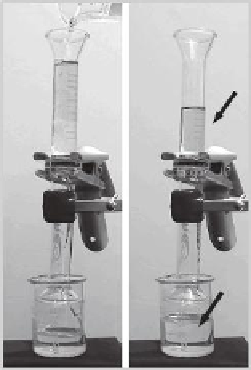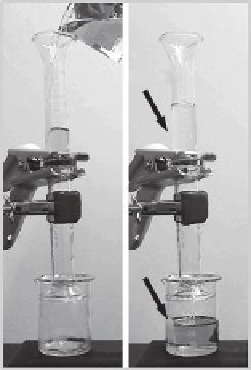Environmental Engineering Reference
In-Depth Information
(a)
(b)
Water
Oil
Oil
Water
FIGURE 7.4
Controllable oil-water separation using the polymer functionalized textile. (a) The functionalized textile was ixed
between two glass tubes as the separation membrane. A mixture of gasoline and water was poured into the upper
glass tube. The gasoline selectively passed through the textile, whereas the water remained in the upper glass tube
(right). (b) The functionalized textile was irst wetted with acidic water (pH 2.0) before the water-oil separation
process. Water selectively passed through the textile, whereas gasoline remained in the upper glass tube (right).
SO
-
NH
+
OO
FIGURE 7.5
Structure of cysteic acid in the zwitterionic form used to increase hydrophilicity of membrane surfaces.
7.3.3 Nanofiber-Based Membranes
An alternative use of nanotechnology in membrane science is to create the membrane out of
nanoengineered materials. The most common approach is to use electrospun nanoibers to
create nonwoven materials that can signiicantly enhance separation eficiency by creating
mats with very high surface-to-volume ratios (10-500 m
2
/g). The fully accessible intercon-
nected nanoporous structure allows for high lux with pore sizes that allow for MF and
UF membrane applications. A unique aspect of the electrospinning technique is the abil-
ity to control the surface functionality by the choice of polymer blend or incorporation of
nanoillers. An excellent review of the electrospun nanoiber membranes for environmen-
tal applications was done by Yoon et al.
47
In terms of application of bilge water treatment,
coalescence of dispersed oil by ibrous membranes and beds has been established for sev-
eral decades.
48-50
One of the irst reported use of nanoiber composite ilters for oil-in-water
separations was by Shin and Chase who tested polyacrylonitrile and poly(meta-phenylene
isophthalamide) electrospun membranes supported on iberglass.
51
Composite ilters
showed improved separation eficiency compared with glass iber membranes, but exhib-
ited higher pressure drops. A similar approach was investigated by Wang and coworkers




